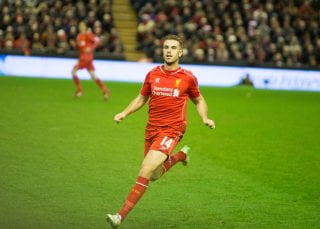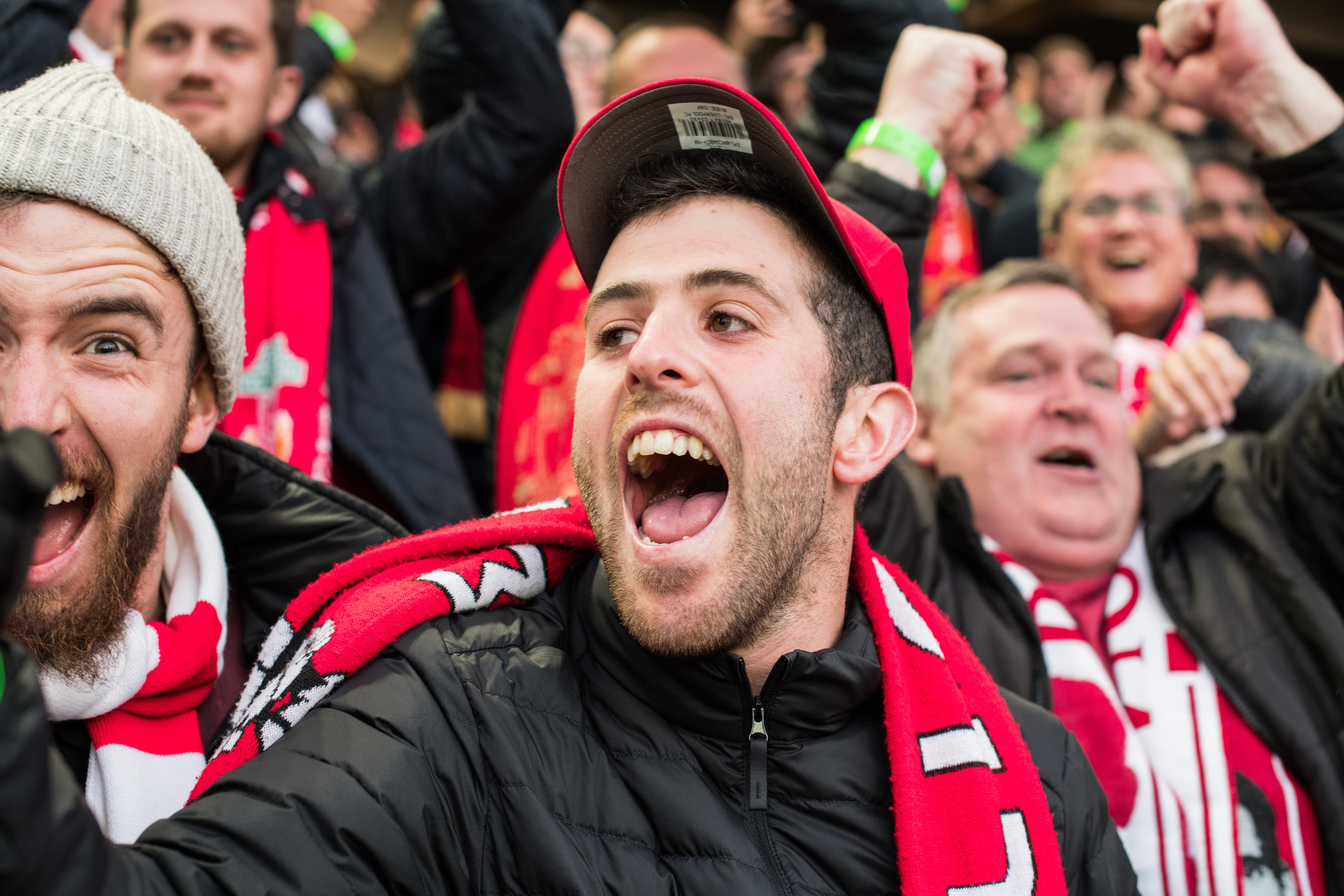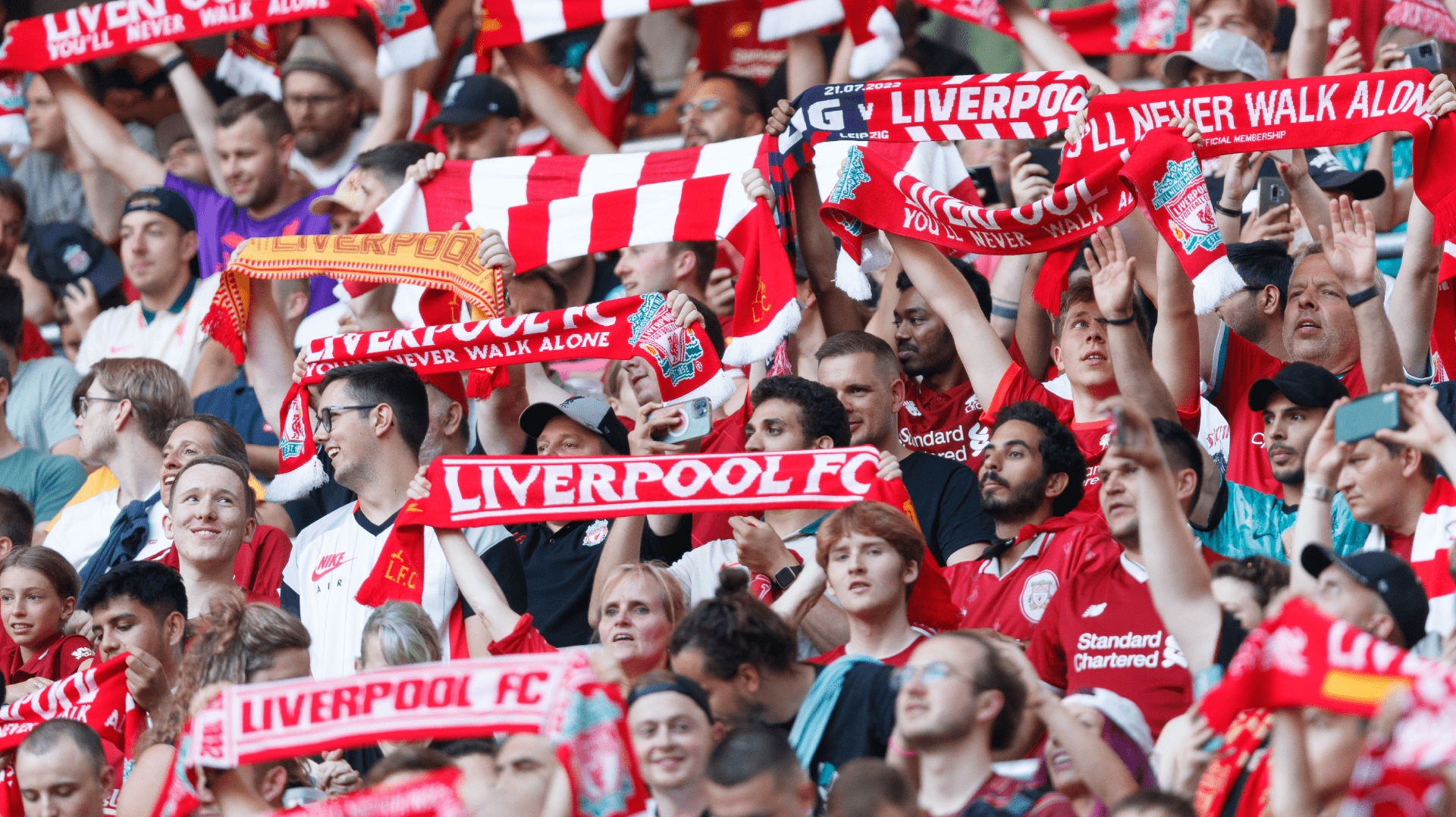
Steffen Prößdorf, CC BY-SA 4.0 <https://creativecommons.org/licenses/by-sa/4.0>, via Wikimedia Commons
By Carson Duca
History
Liverpool Football Club was founded in 1892 by John Houlding, owner of the club’s ground. The club’s ground is known as Anfield, and it still serves as Liverpool’s home stadium. Originally, Everton Football Club played at Anfield, but there was a disagreement between Everton’s directors and Houlding (who was also the president of Everton). Annual rent had risen from £100 in 1884 to £250 in 1892. When the parties involved were unable to come to an agreement, Everton moved to Goodison Park, which also still serves as Everton’s home stadium. Anfield and Goodison Park are less than one kilometer apart, making it the shortest distance between current Premier League stadiums. Unsurprisingly, this contentious origin story for Liverpool has led to a strong rivalry with Everton to this day. Houlding applied to join the Football League First Division with the newly established Liverpool Football Club, but their application was denied, and they were forced to join the regional Lancashire League. The Lancashire League essentially functioned as a steppingstone into the Football League for clubs based in northern England. Liverpool ultimately won the league title, seeing attendance totals as high as 2,000 at Anfield in their first season.
Following this early success, Liverpool reapplied to join the Football League, and this time their application was accepted, giving them a spot in the Second Division in their second season as a club. Liverpool then earned a spot in the First Division for their third season, defeating Manchester United Football Club (known as Newton Heath at the time) in a test match. At this time, finishing as the winner of a lower division did not automatically promote a team to the next highest division. Rather, the team which finished first in the lower division would play a match against the team which finished last in the higher division to determine if the teams would be promoted or relegated respectively. Unfortunately for Liverpool, they were relegated back down to the Second Division for their fourth season. However, Liverpool were promoted back into the First Division for their fifth season. Around this time, the Main Stand of Anfield was constructed, which allowed for attendance totals of around 20,000.
Liverpool won their first League championship in 1901 with defender Alex Raisbeck as their captain. Liverpool signed Raisbeck in 1898 for a fee of £350, and he went on to make 312 appearances for the club. Houlding died in 1902 and the club subsequently went through a process of restructuring ownership. Liverpool were relegated to the Second Division in 1904 before becoming the first team to win the Second and First Division in successive seasons in 1905 and 1906 respectively. Following these titles, a new stand was constructed in Anfield to increase capacity, and this stand would go on to be famously known as the Kop Stand.
During the First World War, the Football Leagues were suspended, but Liverpool competed in regional leagues during that time. Some Liverpool players did fight in the war during this time, and unfortunately one of these players, Wilfred Bartrop, died in warfare. The Football League resumed following the conclusion of the First World War, and the Kop had been expanded to have a standing capacity of 30,000. This made the Kop the biggest football stand in the country at the time, being able to hold more spectators than some entire other stadiums. A few seasons later, Liverpool won their third and fourth First Division title in 1922 and 1923 respectively. However, nothing else as substantive occurred for the club during the interwar period except for the conclusion of goalkeeper Elisha Scott’s 24 years with the club (still the club’s longest-serving player).
Following the conclusion of World War II, League football resumed in England for the 1946–47 season and Liverpool won their fifth First Division title that season. In 1952, Liverpool set their record for highest FA Cup home attendance of 61,905 in the fifth round of the tournament against Wolverhampton Wanderers. Unfortunately, Liverpool also found very little success in these seasons following their fifth First Division title, even getting relegated to the Second Division in 1954. This relegation came after 50 straight years in the First Division. After a few seasons of unsuccessful promotion campaigns in the Second Division, Liverpool appointed Bill Shankly midway through the 1959–60 season as their new manager which would prove to be a pivotal transition in the club’s history.
During this first season for Shankly as Liverpool manager, he gave debuts to Ian Callaghan and Roger Hunt. Callaghan would go on to play in 857 total games for Liverpool (making him the club’s record appearance maker) while Hunt would go on to play in 492 total games for Liverpool, both proving to be very influential to the club during this period. While these two players were getting a foothold in the team, Shankly ultimately released 24 other players by the end of that season. Potentially the most important change, at least to the culture of the club, was the conversion of a boot storage room into a meeting space for Shankly and his coaches to discuss team strategies. Even though an informal space for discussion had its own value in revolutionizing tactical thought for Liverpool, the Boot Room represents a consortium of Shankly and eventual Liverpool managers: Bob Paisley, Joe Fagan, Kenny Dalglish, and Roy Evans. After almost a decade in the Second Division, Liverpool earned promotion to the First Division for the 1962–63 season, and Liverpool have been in the first division of English football ever since.
Everton won the First Division title in that 1962–63 season, but in the following season, Liverpool won its sixth First Division title which included a victory against Everton for their first time since 1950. This found again success in the First Division reinvigorated fans as around this time fans adopted the song “You’ll Never Walk Alone” as the club’s anthem, and Anfield was experiencing an average attendance of over 50,000. Winning the First Division in 1964 qualified Liverpool for a spot in the tenth edition of the European Cup (analogous to the current UEFA Champions League) for the club’s first time. It was during this first European Cup campaign that Shankly made the decision for Liverpool to wear all-red for the first time. Even though an all-red home kit (shorts and socks included) seems synonymous with the Liverpool brand contemporarily, it was not until this season that Liverpool wore red shorts and socks rather than white shorts and socks for their home kit. Shankly was cited as wanting to intimidate opponents with their appearance when rationalizing this decision. Whether there is any psychology to support that reasoning or not, that decision has shaped the club’s identity as Liverpool still wears all-red for their home kit. Unfortunately for Shankly and his team, this change was not enough for them to win the European Cup or defend their First Division title. However, Liverpool won their first-ever FA Cup trophy this season, which was an important new piece of hardware for the club, especially since they had previously been close to winning the tournament a few times.
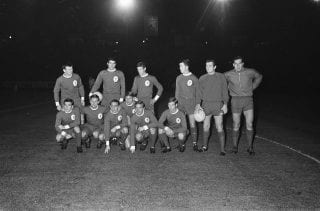
Liverpool team at their match against Petrolul Ploie in Brussels, October 1966. From the Dutch National Archives Anefo, CC0, via Wikimedia Commons
Winning the FA Cup qualified Liverpool for the European Cup Winners’ Cup in the 1965–66 season. This tournament (abolished in 1999) was a competition between the winners of domestic cups from the previous season, and Liverpool finished as runners-up in a final against Borussia Dortmund. Despite this disappointing loss, Liverpool won its seventh First Division title in 1966, making that season largely still a success. Liverpool did not win any trophies until winning their eighth First Division title in the 1972–73 season. This relatively short drought of silverware between 1966 and 1973 represented a transitional period for Shankly’s men as many players left the club during this time span. The new look of the team was exemplified by the statistic that in the 1970–71 season, the team’s average age was 22. That 1972–73 season was also capped off by Liverpool becoming the first English club to win the First Division as well as a European trophy in the same season (Liverpool won the UEFA Cup, which is analogous to the current UEFA Europa League). Also in 1973, businessman John Smith became the chairman, and he ended the club’s policy of changing chairmen every three years. Smith rationalized this change by utilizing his perceived business expertise and proclaiming his belief in continuity. Smith served as the club’s chairman until 1990, and Liverpool experienced much success during this period. One of the first actions done after Smith took over the role was the demolition of the old Main Stand to construct a new version of it. Liverpool won their second FA Cup trophy in the 1973–74 season, and this ultimately would end up being Shankly’s last trophy for the club during his 15 years with Liverpool. Shankly certainly contributed much to the club becoming a powerhouse in both England as well as the continent, so his departure left quite the shoes to fill. In a fitting manner, the aforementioned Bob Paisley was appointed as Shankly’s successor.
Paisley’s first season as manager did not end with any silverware for the club. Paisley’s closest proximity to a trophy was a runner-up finish in the First Division (two points behind champions Derby County). Paisley found much more success by the end of the 1975–76 season where Liverpool won their ninth First Division title as well as their second UEFA Cup trophy. Even better, Paisley’s men won their tenth First Division title and first European Cup trophy in the 1976–77, being one win away from a treble as they lost in the finals of the FA Cup in that season as well. In the following season, Paisley signed Kenny Dalglish for £440,000 who went on to appear in 515 matches for the club as well as score 172 goals and have 167 assists. Dalglish scored 20 goals in 42 league games in his first season at Liverpool, and he scored the winning goal in the European Cup final which meant that the club had successfully defended their trophy from the previous season. This was the first time that a British club were European Cup champions in successive seasons. The next two seasons included Liverpool’s 11th and 12th First Division titles, and during the 1979–80 season, Liverpool became the first British club to have a sponsor on their jersey. Chairman Smith’s decision to add Hitachi on their jerseys as a sponsor was influenced by the club’s need for extra income, according to Smith. In the 1980–81 season, the club won the Football League Cup for the first time as well as the European Cup for the third time. Liverpool won their 13th and 14th First Division titles as well as the Football League Cup for the second and third time across their next two seasons. Also, at the end of this run of seasons, Paisley retired as a manager of the club. During Paisley’s time at Liverpool, he won six First Division titles, three European Cups, and three Football League Cups. It is safe to say that from the perspectives of many, Paisley sufficiently filled the shoes of Shankly across his own nine years as the manager of the club. The next to take the helm was Joe Fagan.
In Fagan’s first season as Liverpool’s manager, the club completed a treble: winning its third consecutive First Division title (totaling to 15), its fourth consecutive League Cup trophy, and its fourth European Cup trophy. However, in Fagan’s second season, the club did not win a single trophy for the first time in nine years. This season also included the devastating Heysel Stadium disaster during the 1985 European Cup final between Liverpool and Italian club Juventus. Following the disaster which unfortunately killed 39 fans, mostly Italians, UEFA found the English fans solely responsible for the deaths as they breached the Juventus fan section, which resulted in mostly Juventus fans being pressed against a collapsing wall. In addition to the deaths, a total of 600 people were injured during the disaster. As a result, English clubs were banned from European club competitions for five seasons and Liverpool were ultimately banned for six seasons. Fagan announced his retirement on the same day as the Heysel Stadium disaster, and he was replaced by Kenny Dalglish who became the club’s first player-manager.
In the 1985–86 season, Dalglish’s first season as player-manager, Liverpool won their sixteenth First Division title (with Dalglish scoring in the last league match to clinch finishing at the top of the league table) as well as their third FA Cup trophy. This also represented the first time that the club had won those two competitions in the same season. At the start of the following season, Ian Rush announced that he would be leaving at the end of the season since the club had expressed its intention to sell him because of a shortage of funds due to their expulsion from European club competitions. Replacing Rush after having him since 1980 was assumed to be a tall task because he had scored 109 goals in that time, but the club was able to win their 17th First Division title in their first season without Rush in 1988. Moreover, Liverpool did not have to be without Rush for too long because he returned to the club on a permanent deal for the start of the 1988–89 season. Liverpool won their fourth FA Cup trophy in that season, but unfortunately the most impactful event that occurred in that season was the devastating Hillsborough disaster during the semi-finals of that tournament.
As mentioned, the Hillsborough disaster occurred during the FA Cup semi-final, a match between Liverpool and Nottingham Forest. Ninety-four people died on the day (three people later died from injuries sustained during the disaster ranging from four days after the event to as recent as 2021) and 766 were injured from overcrowding in the stadium, which led to a human crush. The human crush occurred in the two standing-only pens in the Lepping Lane stand of the Hillsborough Stadium, which had been allocated to Liverpool supporters. Shortly before kick-off, the police match commander opened an exit gate in an attempt to ease overcrowding outside the other entrances of the stadium. However, this only led to overcrowding within the stadium, and the crowd crush led to the highest death toll in British sporting history. Following the event, the South Yorkshire Police fueled false press stories that blamed Liverpool supporters for the disaster. Unlike the Heysel Stadium disaster though, Liverpool fans were cleared of culpability by the Taylor Report, which found the South Yorkshire Police to be at fault for a failure of crowd control which led to the fatalities and injuries. The Taylor Report in 1990 was the first of two inquiries into the event, the second being released by the Hillsborough Independent Panel in 2012. Ultimately, this tragedy spurred the conversion of stadiums in the top two tiers of English football from having fenced-standing terraces to being all-seater stadiums. This change has certainly made stadiums safer, at least in preventing a human crush. One way the victims of the disaster are currently commemorated by Liverpool is by twin flames surrounding the number 97 on the back collar of their jersey. This event is deemed by many as the most devastating aspect of the club’s history, but much was learned from the disaster in its aftermath for all football clubs (and more institutions) when it comes to the logistics and responsibilities of hosting a major public event.
Liverpool won their 18th First Division title in the 1989–90 season, but this would be their last time doing so for thirty years. The club started the following season strongly, winning their first eight league games, but their form eventually declined. So much so that Dalglish announced his resignation as player-manager citing stress as the reason. Ronnie Moran became caretaker manager, but after continued poor form, Moran was replaced by former Liverpool player Graeme Souness as manager. In the 1991–92 season, Liverpool finished outside the top two of the First Division for the first time since 1981, finishing sixth in the table. However, the club did win their fifth FA Cup trophy in this season, and they were also able to compete in the UEFA Cup as their expulsion from European club competitions had officially ended. Additionally, the aforementioned Boot Room was demolished, and a new press room was built in its place. Anfield was renovated for the 1992–93 season to be in compliance with the recommendations of the Taylor Report. This season also marked the inaugural season of the first division of English football being known as the Premier League, but Liverpool finished sixth again, which meant it was yet another underwhelming season by the club’s standards. The following season also included a disappointing finish in the Premier League at eighth. However, the emergence of Robbie Fowler from the club’s academy was a positive sign of production to come as Fowler would go on to score 183 goals as well as have 49 assists for Liverpool. Souness was also sacked during that season, and he was replaced by Roy Evans, the last of the “Boot Room managers.”
In the 1994–95 season, the Kop was redeveloped to become an all-seater section, reducing its capacity to 12,000. Liverpool won their fifth League Cup trophy this season while also having their best finish in the league since the resignation of Dalglish, finishing in fourth. Liverpool’s next few seasons were uneventful as far as trophy success was concerned, but Michael Owen’s emergence from the club’s academy in the 1997–98 was timely as Fowler had suffered a knee injury in a pre-season friendly. Owen would go on to score 158 goals as well as have 41 assists during his career at Liverpool. The club struggled for the next two seasons, and during this time Gérard Houllier was appointed as co-manager before Evans eventually resigned due to the prolonged poor performances of the team. Steven Gerrard also made his debut for the senior team in the first half of the 1998–1999 season. Gerrard would go on to make 710 appearances, score 186 goals, and have 145 assists for the club, and he is considered by many as the best Liverpool player ever as well as one of the best midfielders of all time.
In the 2000–01 season, Liverpool completed a treble winning their sixth League Cup trophy, sixth FA Cup trophy, and third UEFA Cup trophy. The club also finished third in the Premier League which qualified them for the following season’s European Cup (now known as the UEFA Champions League) for the first time since the Heysel Stadium disaster. Unfortunately, no trophies were won in the following season, and Houllier’s heart issues meant that his assistant, Phil Thompson, had to act as interim manager for portions of the season. In the 2002–03 season, Liverpool won their seventh League Cup trophy. At the end of the following season, Houllier was replaced by Rafael Benítez.
Like the club’s previous few managers, Benítez would never win the Premier League with Liverpool, but he managed the team for arguably their most famous match of all time which is known as the Miracle of Istanbul. During the 2005 Champions League Final held in Istanbul, Liverpool trailed AC Milan at half-time by a score of 0-3, but three goals in six minutes allowed Liverpool to push the match to a penalty shootout where Liverpool would emerge victorious. This was the club’s fifth European Cup trophy, the first since it had been known as the Champions League. The following season included Liverpool’s seventh FA Cup trophy. In 2007, American businessmen George Gillet and Tom Hicks bought the club with a valuation of £218.9 million. After six years with Benítez as a manager, a Champions League title overshadowed the multiple near misses in domestic competitions for the club in this span of seasons, and Benítez was replaced by Roy Hodgson in 2010.
Also in 2010, Liverpool was sold to its current owners, Fenway Sports Group, for £300 million. Hodgson’s short stint at the club came to an end in 2011 when he was replaced by former player-manager Kenny Dalglish. 2011 also included the signings of Luis Suárez as well as previous club captain Jordan Henderson. In less than four years, Suárez scored 82 goals and had 29 assists for the club. Suárez is certainly a divisive player due to incidents involving biting and racial abuse, making these two transfers have a unique dichotomy as Henderson is a highly respected leader who had 492 appearances for Liverpool. Nevertheless, both players are extremely influential in the recent history of the club. Liverpool won their eighth League Cup trophy in 2012, but Dalglish was sacked at the end of this season and replaced by Brendan Rodgers. In the 2013–14 season, Liverpool finished second in a close title race, which came down to the final matchday of the season, but they ultimately finished two points off champions Manchester City. In the summer of 2014, Suárez was sold to Barcelona. Additionally, in January 2015, Steven Gerrard announced that he would be joining LA Galaxy at the end of that season after 17 years with Liverpool. Gerrard is still hailed as a club legend despite never winning a Premier League title. Lastly, Rodgers was replaced after a poor start to the 2015–16 season, which meant that Liverpool was about to enter its current era with manager Jürgen Klopp.
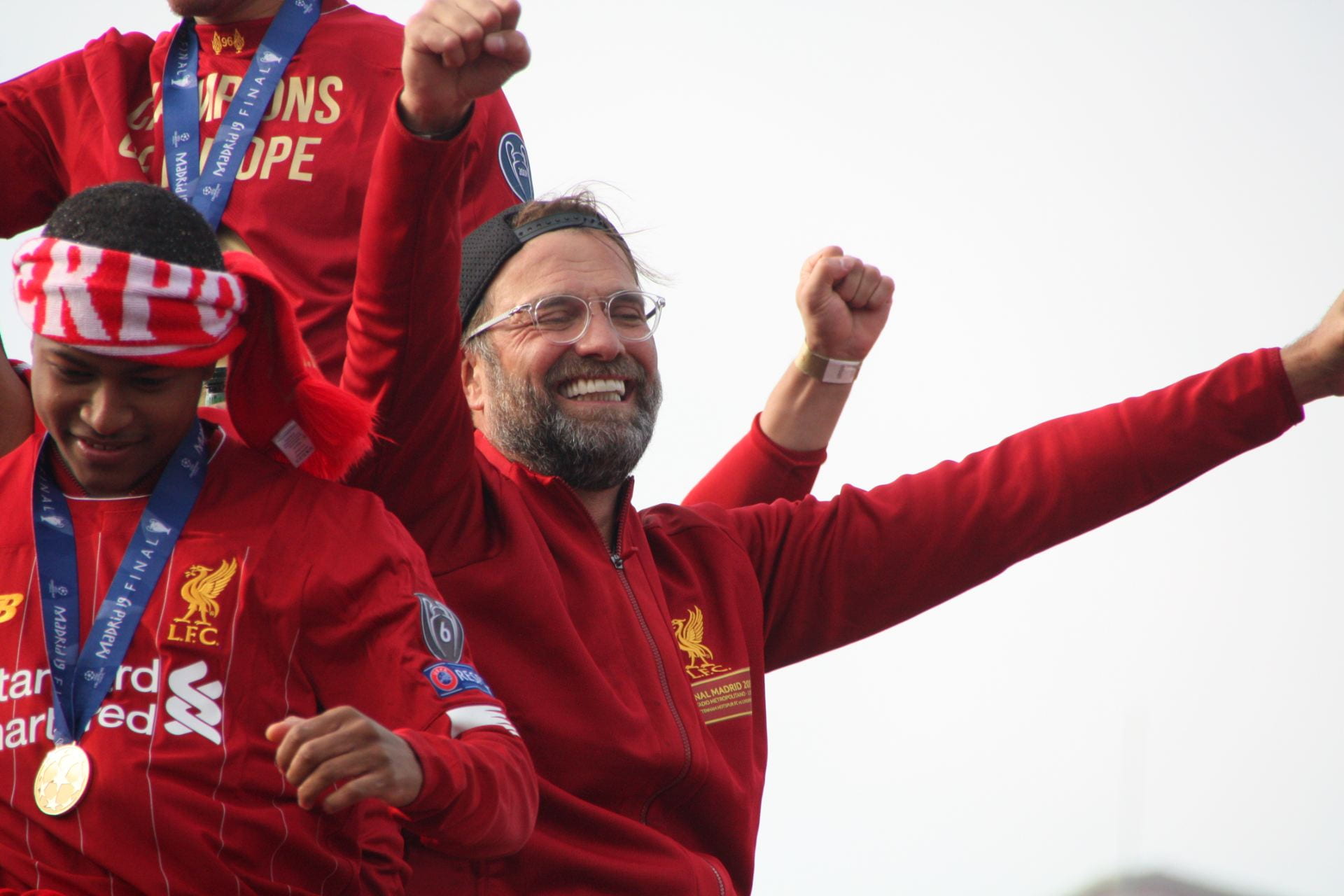
Jurgen Klopp during Liverpool’s trophy parade after winning Champions League in 2019. (Pete, CC0, via Wikimedia Commons)
Some of Klopp’s first few influential signings included forward Sadio Mané in the summer of 2016, forward Mohamed Salah in the summer of 2017, defender Virgil van Dijk in January 2018, and goalkeeper Alisson Becker in the summer of 2018. Trent Alexander-Arnold’s emergence from the club’s academy to make his Liverpool senior team debut in October of 2016 also was extremely influential for the future success of the team. Within Klopp’s first few seasons with Liverpool, the team lost in three finals: the 2016 Football League Cup Final, the 2016 Europa League Final, and the 2018 Champions League Final. In the 2018–19 season, Liverpool finished second in the Premier League despite having 97 points which was the third-highest total in the history of First Division English football and the most points scored by a team without winning the title. However, the disappointment of this hard-fought runners-up finish was eased as the club won their sixth European Cup trophy after a massive comeback in the second leg of the Champions League semi-finals against Barcelona, which is already viewed as a classic match by many Liverpool fans. This win in the 2019 Champions League Final also marked the end of a seven-year trophy drought. In the 2019–20 season, Liverpool ended their 30 year drought for a First Division title, winning the league for the first time since it had been known as the Premier League (making it the club’s 19th league title). Even though this season was interrupted by the coronavirus pandemic, Liverpool handily won the title with a record seven games left in the season.
Current Sentiments of Fans
In the 2021–22 season, Liverpool played in every match possible as they reached at least the finals of every tournament they competed in. The competitions they played in included the Premier League, FA Cup, EFL Cup, and UEFA Champions League, totaling 63 matches for the season. If Liverpool would have won each of these competitions, they would have only been the second team in football history to win a quadruple (the first and only team being 1966–67 Celtic). Instead, Liverpool ended up winning the FA Cup and EFL Cup while finishing as runners-up in the Premier League and Champions League. This season was still viewed as a success, winning a double is no small feat, but being in touching distance from all four trophies felt bittersweet for most Liverpool fans. Going into this season, Liverpool fans were quite optimistic about making a deep run in each of these competitions again despite the loss of Sadio Mané in the 2022 summer transfer window. The promising 2022 January transfer of Luis Díaz also provided some reassurance that the loss of Mané would hopefully not be too devastating. Additionally, the signing of Darwin Núñez in the 2023 summer transfer window excited many Liverpool fans as they were hopeful that this transfer in conjunction with Mohamed Salah signing a new contract with the club would allow Liverpool to continue challenging for trophies. Salah has scored 186 goals and has had 74 assists for the club in 305 appearances as of writing, making him one of Liverpool’s best players of all time, so this contract extension was great news. Fans were further inspired just before the start of the season as Liverpool defeated Manchester City in the FA Community Shield, a match between the previous season’s Premier League winners and the holders of the FA Cup.
However, things quickly went downhill for Liverpool at the start of the 2022–23 season. Liverpool’s first match of the Premier League resulted in a draw away from home against newly promoted Fulham followed by a draw against Crystal Palace at Anfield and a loss against Manchester United at Old Trafford. Two points in their first three matches certainly was not the ideal start to the Premier League campaign for Klopp’s men. Then in Liverpool’s fourth match, they tied the record for the largest win in the history of the Premier League with a 9-0 thrashing against newly promoted Bournemouth at Anfield. This drastic inconsistency of the start to the season seems to have foreshadowed how the rest of the club’s season would go. Since then, Liverpool have added even more blowouts, defeating Manchester United 7-0 at Anfield and Leeds 6-1 away from home. The 7-0 match against Manchester United also included the biggest-ever competitive loss for Manchester United while Mohamed Salah became Liverpool’s record Premier League scorer that day. Despite these massive wins, Liverpool were eliminated from all tournaments that they competed in while finishing fifth in the Premier League, outside of the qualification spot for next season’s Champions League. Something that had helped keep Liverpool fans hopeful for portions of this season was the transfer of Cody Gakpo in January following his impressive performances for the Netherlands at the 2022 FIFA World Cup. However, the potential signing of prodigious midfielder Jude Bellingham from Borussia Dortmund is what made many Liverpool fans aspirational during this time despite actual performances by Liverpool during the season being subpar by the club’s standards. Liverpool have been linked with Bellingham across the past few transfer windows, however, the possibility (or at least hype) of this signing coming to fruition seemed to really take shape during the World Cup in the winter. Unfortunately, as many practical Liverpool fans have known for quite some time, the price for the 20-year-old English midfielder (who has since signed with Real Madrid) far exceeds what the club is willing to spend, especially since multiple signings seem to be necessary as Klopp’s team hopes to rebuild and enter its next era.
Future Goals
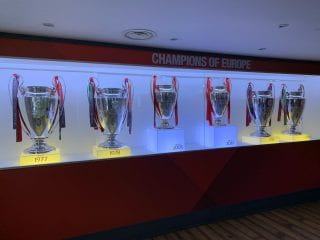
Liverpool trophies from the UEFA Champions League Damine178, CC BY-SA 4.0 <https://creativecommons.org/licenses/by-sa/4.0>, via Wikimedia Commons
Liverpool’s trophy cabinet over 130 years as a club includes 19 First Division league titles, nine League Cups, eight FA Cups, six European Cups, three UEFA Cups, and even more from other competitions. In April of 2022, Klopp signed a contract extension, which keeps him at Liverpool until 2026, so the club is certainly standing strong in support of the German manager. Fenway Sports Group seemingly put the club up for sale in November of 2022, but the owners have since ruled out the possibility of a full sale. Nevertheless, acquiring new minority investors could still bolster Liverpool’s spending for the future with the current summer transfer window being an opportunity to hopefully further upgrade the squad. Despite the previous season feeling like a lost cause by the club’s standards, Klopp has experimented with various tactical changes, which has improved recent performances. An improvement in performances is integral to garner momentum and finish the season strongly to make Liverpool as attractive of a landing spot as possible for future transfer targets. So far, Liverpool have signed Argentinian midfielder Alexis Mac Allister from Brighton & Hove Albion as well as Hungarian midfielder Dominik Szoboszlai from RB Leipzig. Liverpool have also let go of some of their most impactful players of their recent history in club captain Jordan Henderson and Fabinho, so signing at least one more midfielder as well as a defender seems almost necessary before the close of the transfer window at the end of August. Virgil van Dijk has been named the new captain of the club while homegrown talent Trent Alexander-Arnold has been named the vice-captain as the team enters a new era under the management of Jürgen Klopp. Ultimately, Liverpool Football Club has an extremely rich history, and even though all clubs go through underwhelming periods, fans of Liverpool are privileged to support a club that is consistently competitive and challenging for the most highly coveted trophies in the sport.
Carson Duca is an honors student majoring in sociology and criminology and Spanish and legal studies. Outside of academics, Carson loves soccer. His favorite club is Liverpool, and he will attend his first game this fall before studying abroad at the University of Sussex. He’s excited the American Express Community Stadium is near campus, so we can watch Bright and Hove Albion play throughout the semester.

